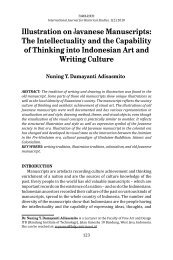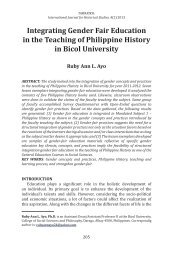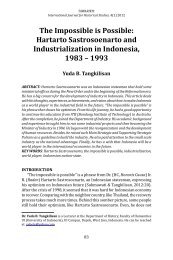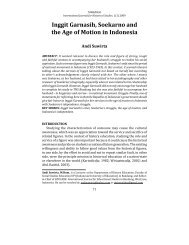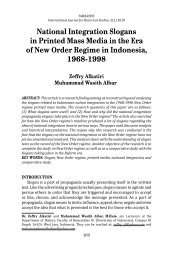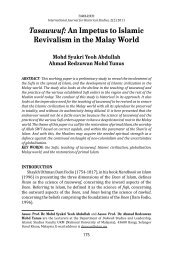The full article is as follows. - Tawarikh Journal
The full article is as follows. - Tawarikh Journal
The full article is as follows. - Tawarikh Journal
Create successful ePaper yourself
Turn your PDF publications into a flip-book with our unique Google optimized e-Paper software.
ISMAIL ALI,<br />
Observation and D<strong>is</strong>cussion on the H<strong>is</strong>tory of Maritime Archipelago<br />
spread of Chr<strong>is</strong>tianity by the Span<strong>is</strong>h people in the Philippines. For the<br />
abovementioned scholars, piracy in Malaya (Straits of Malacca), Borneo<br />
Islands, Indonesia and the Philippines <strong>is</strong> a local response towards the Western<br />
colonization that had monopolized their trades, taken over their power,<br />
spread Chr<strong>is</strong>tianity (the Philippines c<strong>as</strong>e) and conquered their lands.<br />
WRITING THE HISTORY OF MARITIME AS AN ACT OF UNITING<br />
THE PEOPLE OF THIS ARCHIPELAGO<br />
Before the coming of foreign powers to the states of Southe<strong>as</strong>t Asia, these<br />
states, <strong>as</strong> called by Lynda N. Shaffer (1996), were known <strong>as</strong> maritime realm<br />
<strong>as</strong> they had kingdoms that were b<strong>as</strong>ed on strong maritime concept and<br />
they were also terrified by the agrarian kingdoms of the Southe<strong>as</strong>t Asian<br />
<strong>is</strong>lands and mainland. Among the kingdoms were Srivijaya and Majapahit<br />
of Indonesia; the Malacca Malay reign in Malaya; and the Sulu Sultanate in<br />
the southern Philippines. 1 H<strong>is</strong>torically, the emergence and development of<br />
these kingdoms <strong>as</strong> the powerful economic and politic states of th<strong>is</strong> region<br />
<strong>is</strong> due to the w<strong>is</strong>dom of its ruler who used se<strong>as</strong> and straits <strong>as</strong> means of<br />
trading and ports, which at the end made them <strong>as</strong> the maritime power and<br />
trading emporium between E<strong>as</strong>t and West; the rulers’ ability to mobilize<br />
<strong>full</strong>y the state’s natural sources and its people (Sea people and slaves) in<br />
nearby states h<strong>as</strong> also made them the most powerful economic and politic<br />
states of th<strong>is</strong> region.<br />
<strong>The</strong> rulers’ w<strong>is</strong>dom on developing the economy and political power<br />
during the 7 th until 17 th centuries h<strong>as</strong> enabled the region to develop and<br />
become the focus for traders from all over the world to come; and th<strong>is</strong><br />
period w<strong>as</strong> called by Anthony Reid <strong>as</strong> the age of commerce (1988). Before<br />
the 13 th century, geo-politically, the establ<strong>is</strong>hment of these kingdoms<br />
in th<strong>is</strong> region w<strong>as</strong> limited due to space, power and obviously they were<br />
separated from each other. However, th<strong>is</strong> pattern and geo-politic started to<br />
change during the 13 th century with the emergence of Majapahit reign in<br />
Java. Under the reign of Hayam Wuruk and Patih Gadjah Mada, the states<br />
of th<strong>is</strong> region began to be united under one name, which <strong>is</strong> known <strong>as</strong> the<br />
Archipelago, <strong>as</strong> v<strong>is</strong>ioned by Patih Gadjah Mada. <strong>The</strong> Archipelago, 2 which <strong>is</strong><br />
1 For further explanation refer to h<strong>is</strong>torical journey of Srivijaya and Majapahit, see Paul<br />
Michel Munoz (2006); for further explanation refer to the h<strong>is</strong>torical journey of the Sulu<br />
Sultanat, see Teodoro A. Agoncillo (1974); and James F. Warren (1981).<br />
2 During the ancient ages, there were a lot of names were given to the <strong>is</strong>lands found<br />
in Southe<strong>as</strong>t Asia. <strong>The</strong> voyagers from China named the <strong>is</strong>lands of th<strong>is</strong> region <strong>as</strong> Nan-Hai<br />
(Islands of the Southern Sea); ancients Indian notes called the <strong>is</strong>lands <strong>as</strong> Dwipantara (the<br />
<strong>is</strong>lands of the other land) i.e. a name that w<strong>as</strong> taken from Sansekerta language that <strong>is</strong><br />
150



